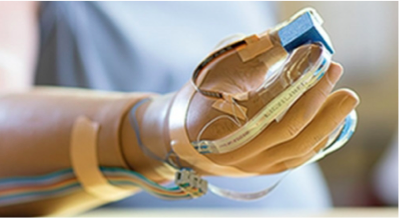Recent years have brought huge advances in prosthetics, but there is still much work to be done in replicating the intricacy of the human hand. Scientists have developed ways to let patients control pros- thetic limbs with their existing nerves, but that communication is only one way — the prosthetic hasn’t been able to send anything back. That might be about to change as researchers are seeing success with a new system that can convey a sense of touch from a prosthetic limb.
By sending touch sensations from a prosthetic hand, re- searchers hope to give patients the ability to accomplish complex tasks currently impossible or impractical with an artificial limb. While control of grasping is much better than it used to be, it’s too easy for the patient to crush objects or lose their grip. The new system under development can send pressure data from 20 points on the hand to the peripheral nerves in the remaining limb, giving a sensation of touch.
 The work done by researchers at Cleveland Veterans Affairs Medical Center and Case Western Reserve University relies on a device called a cuff electrode. The electrodes are small — just 7mm long and are implanted in the arm to stimulate three nerve bundles. A cuff electrode is seen as more viable in the long term because it only compresses the nerves to deliver signals through the myelin sheath. Other technologies put electrodes in direct contact with the nerve cells for more sensitivity, but cannot be used for long periods.
The work done by researchers at Cleveland Veterans Affairs Medical Center and Case Western Reserve University relies on a device called a cuff electrode. The electrodes are small — just 7mm long and are implanted in the arm to stimulate three nerve bundles. A cuff electrode is seen as more viable in the long term because it only compresses the nerves to deliver signals through the myelin sheath. Other technologies put electrodes in direct contact with the nerve cells for more sensitivity, but cannot be used for long periods.
Two people have been fitted with the touch detection sys- tem, and have been testing it successfully for 18 months. An electrical interface with nerve tissue lasting that long is amazing in its own right — this makes the technology potentially viable for integration into real prosthetics that people use every day. Researchers believe that over time they can tune the sensory input to replicate the feel of specific surfaces with help from more advanced force detectors.
